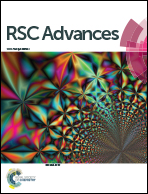A study of nanogels with different polysiloxane chain lengths for photopolymerization stress reduction and modification of polymer network properties†
Abstract
This paper reports a series of nanogel compositions synthesized with methacrylate-modified polysiloxanes of different chain lengths, urethane dimethacrylate (UDMA) and isobornyl methacrylate (IBMA) at molar ratios of 10 : 20 : 70 in the presence of a thiol chain transfer agent. The nanogel structures were characterized by proton nuclear magnetic resonance (1H-NMR), Fourier transform-infrared spectroscopy (FT-IR), gel permeation chromatography (GPC) and transmission electron microscopy (TEM). From simultaneous measurement of real-time kinetics and shrinkage stress during photopolymerization, the nanogel additives showed a significant delay in the onset of stress and further reduce the overall photopolymerization stress without compromising the mechanical properties of the corresponding polymers. Most importantly, it is also proved that thermostability, flexibility and hydrophobic properties were improved by the introduction of polysiloxane-based nanogels into UV-curable materials due to high temperature resistance, excellent flexibility and low surface energy associated with the polysiloxane component.


 Please wait while we load your content...
Please wait while we load your content...